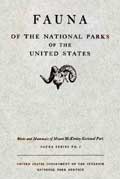.gif)
MENU
|
Fauna of the National Parks — No. 3
Birds and Mammals of Mount McKinley National Park |

|
Birds
DESCRIPTIONS OF BIRD SPECIES
ALASKA PINE GROSBEAK
Pinicola enucleator alascensis [RIDGWAY]
GENERAL APPEARANCE.—A bird nearly as large as a robin, with a dark thick short bill. The general body color is dull gray but the adult male is strongly suffused with bright scarlet on the head, breast, wings, and back. The females and young birds of both sexes are yellow on the head and rump. Length, 9 inches.
IDENTIFICATION.—The thick dark bill and the bright scarlet of the male, and the yellow hue of the female and young are the best field characters. These birds are prone to choose exposed perches in the very tops of spruce trees.
DISTRIBUTION.—It breeds from Mount McKinley, northwestern Alaska, and Mackenzie south to northern British Columbia.
HABITS.—The Alaska pine grosbeak is one of the hardy songsters of the north. Although there is a general southward movement of the birds, many of them winter throughout the interior of Alaska. Charles Sheldon did not see any on the Toklat during the winter from November 7, 1907, to March 12, 1908.
This bird is common in the McKinley region during the spring and fall migrations but we have been unable to find it breeding there.
HEPBURN'S ROSY FINCH
Leucosticte tephrocotis littoralis [BAIRD]
GENERAL APPEARANCE.—A large finch with a body of seal brown color washed with bright rose on the wings, rump, flanks, and abdomen. The head is gray and has a black crown patch. Length, 6.1 inches.
IDENTIFICATION.—The best field characters for this bird are its coloration—brown with a rosy wash—together with its habit of living and nesting high above timber line amid cliffs, broken rock slides, and snowbanks.
DISTRIBUTION.—It breeds above timber line in mountains from the Alaska Peninsula and Mount McKinley south to central Oregon. It is common in the cliff regions high above timber line in the vicinity of Mount McKinley National Park.
HABITS.—When Superintendent Liek and his party climbed Mount McKinley in April 1932, the birds which were found living farthest up on this "highest mountain in North America" were rosy finches. They were observed flying overhead and toward the cliffs at a point slightly above 7,500 feet elevation.
Sheldon reports the earliest spring arrival at the Toklat on May 3, 1908. On May 27, 1926, I found a pair of rosy finches feeding on weed seed where a few bare places were beginning to appear in the snow on Mount Healy at 4,200 feet. Examinations of the crop contents of two specimens collected showed an exclusive vegetable diet. This was a mated pair of birds apparently about to nest, since the female contained an egg that would have been laid within 2 or 3 days. Another female collected June 6, 1926, contained an egg fully formed and ready to lay.
On June 12, at Double Mountain high above timber line I observed two pairs of rosy finches entering cracks in conglomerate cliffs. Both of the vivid red males were vibrant with their bubbling mating song. One of the birds made repeated trips into a nest crevice carrying nest material which consisted of dry plant stems.
On June 28, 1926, rosy finches were found nesting in the cliffs on the snowy summit between Riley Creek and Savage River.
This bird is a regular breeding species in the McKinley region and its nesting seems to be but slightly retarded by cold, snow, and other adverse weather conditions.
COMMON REDPOLL
Acanthis linaria linaria [LINNAEUS]
GENERAL APPEARANCE.—A small finch with a short, sharp bill. Its back and flanks are streaked with brown and ashy, and it has a crimson crown cap. The adult male has a rosy breast. The females have the crimson crown patch and the black chin spot of the male but they lack the rosy breast of the male. Length, 5 inches.
IDENTIFICATION.—The small size, the streaked plumage, the red crown patch, and the black chin spot are the outstanding field characters of this bird.
DISTRIBUTION.—In North America it breeds from northwestern Alaska and Mackenzie south to Alberta and Manitoba and is resident in the willow areas throughout the McKinley region.
HABITS.—Charles Sheldon (1930, p. 402) states that the redpolls were seen in the Toklat area throughout the year but that few birds remained at timber line in winter. About April 15 they return to timber line and remain there to breed.
On May 21, 1926, I found three mated pairs of redpolls on Savage River. They were foraging in a willow thicket along the margin of a shallow pool in the river bed. Two of these birds were collected for specimens and their throats were found to contain many weed seeds.
On June 1, 1926, I found a redpoll's nest 5-1/2 feet above the ground in the crotch of a willow. The female was flushed from the nest which was found to contain two fresh eggs. When it was visited again on June 7, the nest contained a full set of five eggs. It was composed of plant fiber and weed stalks and measured 4 inches across and 3-1/2 inches in depth—outside measurements. The inside measurements of this nest were 2-1/2 by 1-3/4 inches, with a depth of 1-1/2 inches. It was lined with white ptarmigan feathers.
A second redpoll nest was found within a quarter of a mile of the first nest. It was also placed in the crotch of a willow and was a bulky affair profusely lined with white ptarmigan feathers which made it conspicuous even at a distance.
Redpolls were as common in 1932 as they were in 1926. A sharp watch was kept for the hoary redpoll but none was found; the common redpoll is the breeding bird in the McKinley region.
NEXT >>>
 Top
Top
Last Modified: Thurs, Oct 4 2001 10:00:00 pm PDT
http://www.cr.nps.gov/history/online_books/fauna3/fauna9j13.htm
![]()
